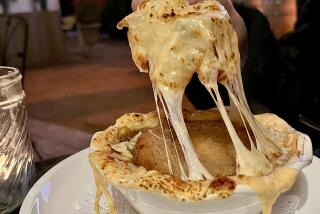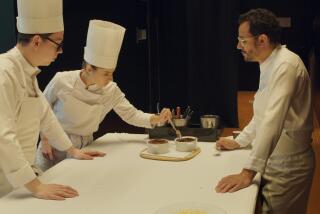Think French
- Share via
It took the French Revolution to make classical French cuisine what it is today. Without it, French food would have remained an elitist, snob cuisine limited to nobility and the very rich.
When the aristocrats were overthrown, a lot of house chefs were out of work. And so they opened restaurants (still a novelty in those days) and introduced haute cuisine to commoners. Brillat-Savarin described the period as a time for each citizen “to make, according to his purse or appetite, copious or delicate meals, which formerly were the perquisite of the very rich.”
France’s restaurant chefs saw to the further development of its cuisine by continually trying to outdo each other and, in the process, educated people to demand the best raw ingredients for their stockpots and an incredible variety of foodstuffs in the marketplace. They stuffed, rolled, ground, pureed, creamed, buttered and flamed their way to glory, and the people wanted more.
They also sent legions of well-trained chefs and cooks throughout the world to set and maintain the standard of excellence by which all other cooking is judged. We wouldn’t cook our own American food so well if we hadn’t been greatly influenced by France and its cooks.
When you feel like cooking something French, simply put yourself into a French state of mind. Food is more than a list of products, and French food is more than foie gras , white asparagus, triple-cream cheeses, marrons glaces, frogs’ legs, brains and sweetbreads, creme fraiche and butter. It’s more than the sum of its regional specialties-- pot-au-feu , cassoulet, homard a l’americaine , sauce bearnaise. It’s a mentality of eating.
Plan your menu carefully. The French, perhaps more than any other people, look at the whole dinner as if it were a single recipe, with each course being an ingredient that has been chosen for what it adds to the meal. French dinners may be saucier than others, but there are never two sauces on the same plate. Don’t serve every course in a sauce or follow a cream sauce with another cream sauce. The model, even today in France, is lightness, both in the choice of ingredients used and in the choice of dishes prepared.
It’s typically American, for example, to serve everything at the same time. There’s the main course, a couple of sides of potatoes and vegetables, and in many homes, even the salad bowl graces the table. Now, in the French manner, whether dinner is a formal, long one or a more familial, casual one, the French cook exercises control over how the dinner progresses. Things are served in courses. Each dish, although perhaps not soigne or fancy, gains importance by its unique presentation.
When I was at school in France, standard recipe portions were about four to five ounces of meat--a good two or three ounces less than called for in most American recipe books. We find four to five ounces of meat skimpy, because in an American meal there is often nothing else but a potato, perhaps a vegetable and the dessert, and that’s that.
In France, though, there’s always a first course, perhaps a cold cut, some pate or a marinated fish such as herring or mackerel. There’s the main dish, usually accompanied by a starch or vegetable, followed by a green salad and cheese, and finally dessert. That’s the simplest dinner there is, and four ounces of meat is generally a satisfying amount of food.
BLANQUETTE OF VEAL AND CAULIFLOWER
3 pounds boneless veal stew meat
6 cups fresh or canned low-sodium chicken broth
1 medium onion, cut in halves
2 celery stalks, each cut in halves
1 medium carrot, cut in halves
1/2 teaspoon salt or to taste
1/2 teaspoon black peppercorns
1/4 teaspoon ground nutmeg
1/2 lemon
5 tablespoons flour
5 tablespoons unsalted butter
2 1/2 cups cauliflower florets (from 1 pound cauliflower)
3/4 cup sour cream
Combine veal and 4 cups broth in 5-quart heavy pot over high heat. Cover and bring to boil. Remove any scum that comes to top of pot. Add remaining 2 cups broth, onion, celery, carrot, salt, peppercorns, nutmeg and lemon. Reduce heat to low and simmer 1 1/4 hours, or until meat is just tender.
Remove cooked veal from liquid, using slotted spoon. Discard any vegetables that cling to meat. Strain broth, discarding vegetables.
Melt butter in medium pot over low heat. Whisk in flour. Cook, stirring, 2 minutes. Add veal broth, whisking vigorously. Cook, stirring, until mixture thickens, about 3 to 5 minutes. Add cauliflower and continue to cook additional 15 minutes, skimming off any residue that rises to surface.
At serving time, add veal to cauliflower and sauce and heat through. Place sour cream in mixing bowl, whisk in 1/2 cup of hot sauce, then add to stew. Do not reheat. Pour stew into serving dish and accompany with rice pilaf or buttered noodles. Makes 6 servings.
Each serving contains about:
591 calories; 967 mg sodium; 198 mg cholesterol; 37 grams fat; 14 grams carbohydrates; 49 grams protein; 0.74 gram fiber.
More to Read
Eat your way across L.A.
Get our weekly Tasting Notes newsletter for reviews, news and more.
You may occasionally receive promotional content from the Los Angeles Times.









